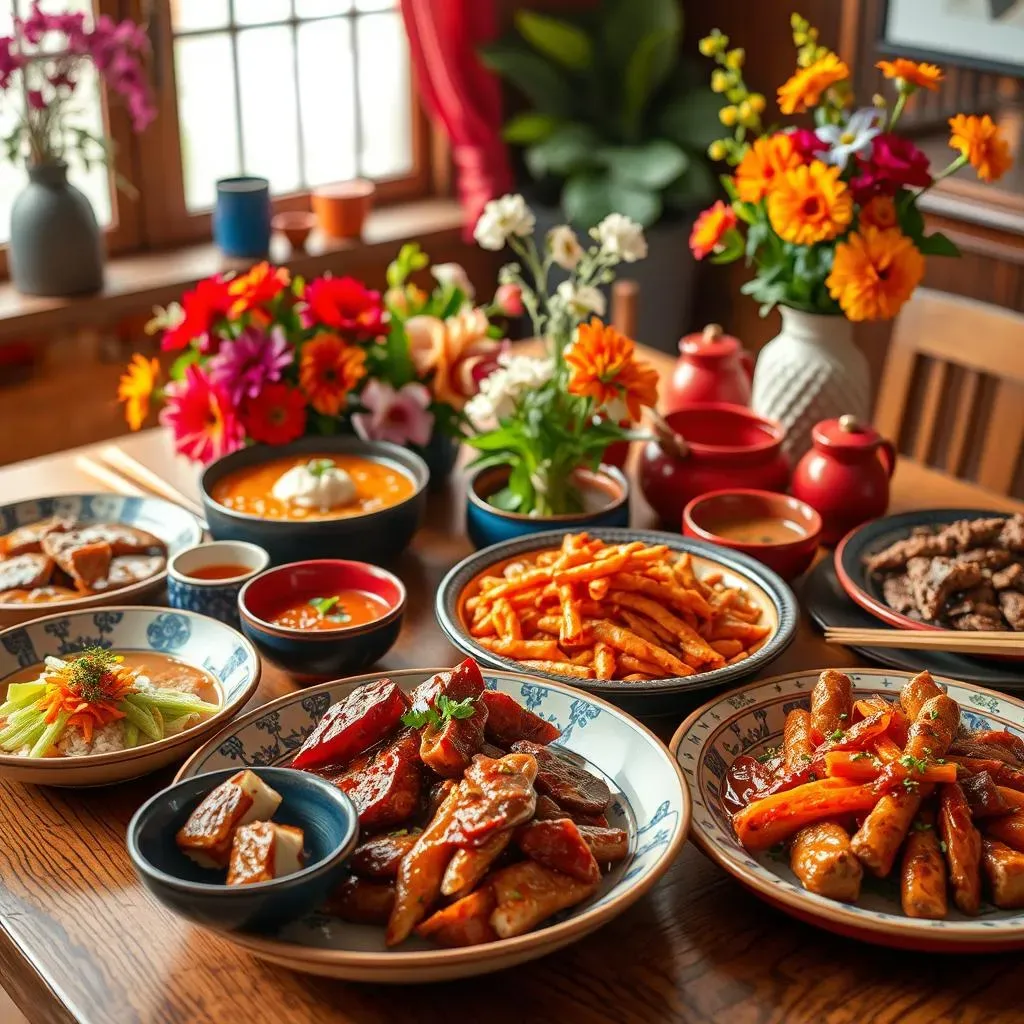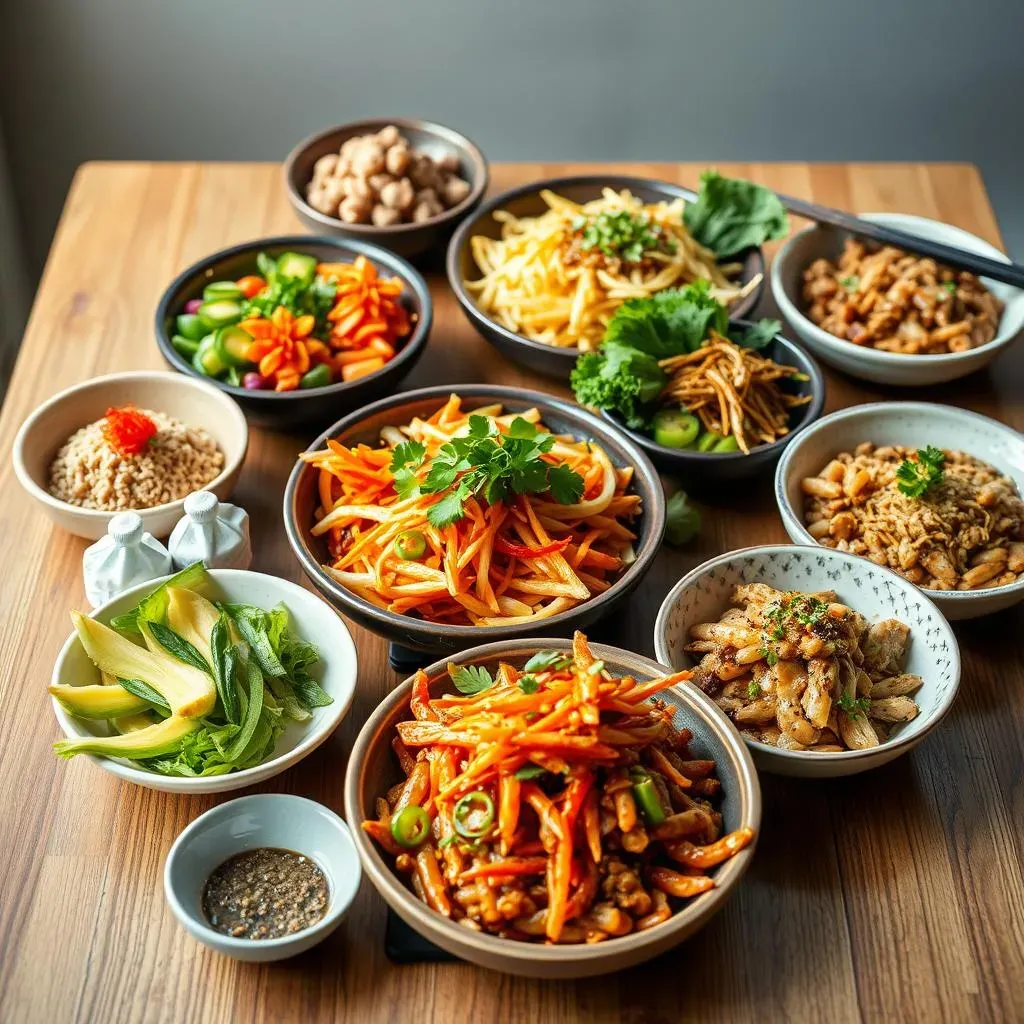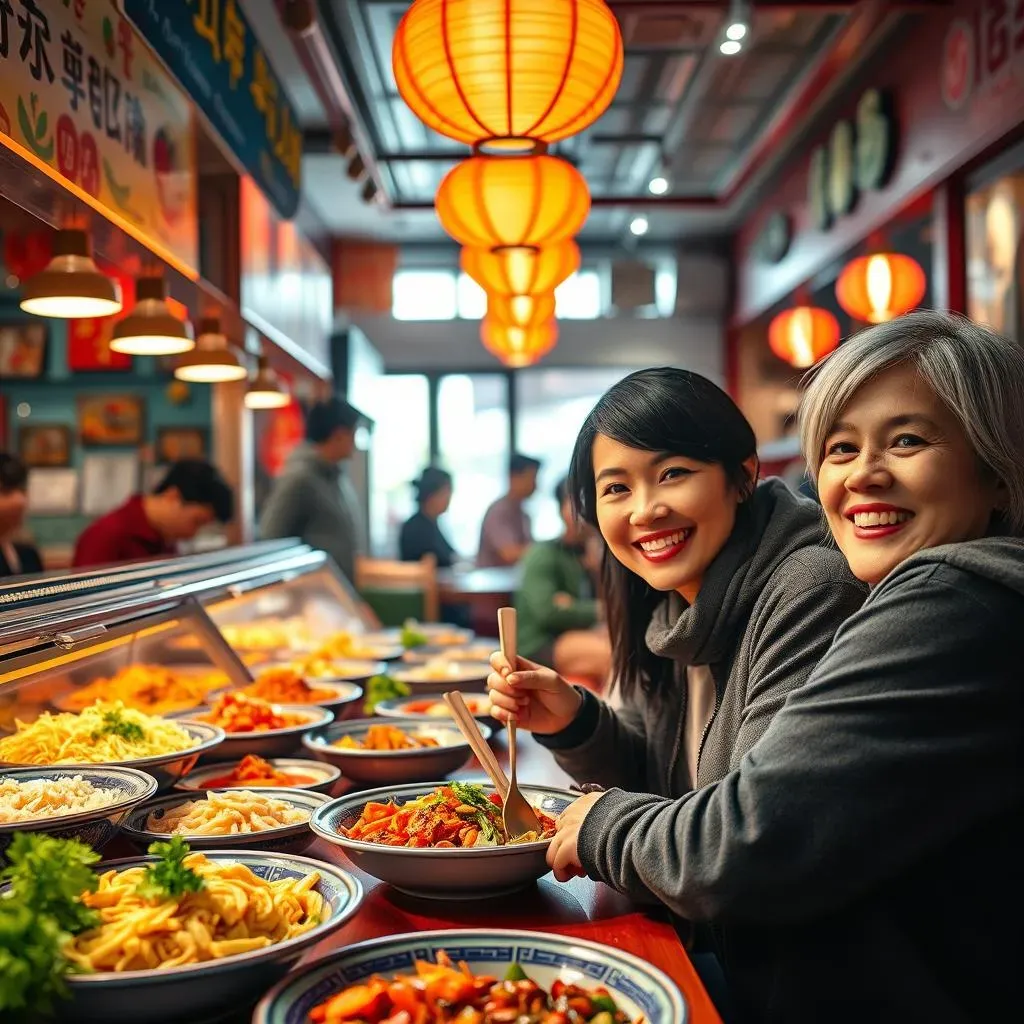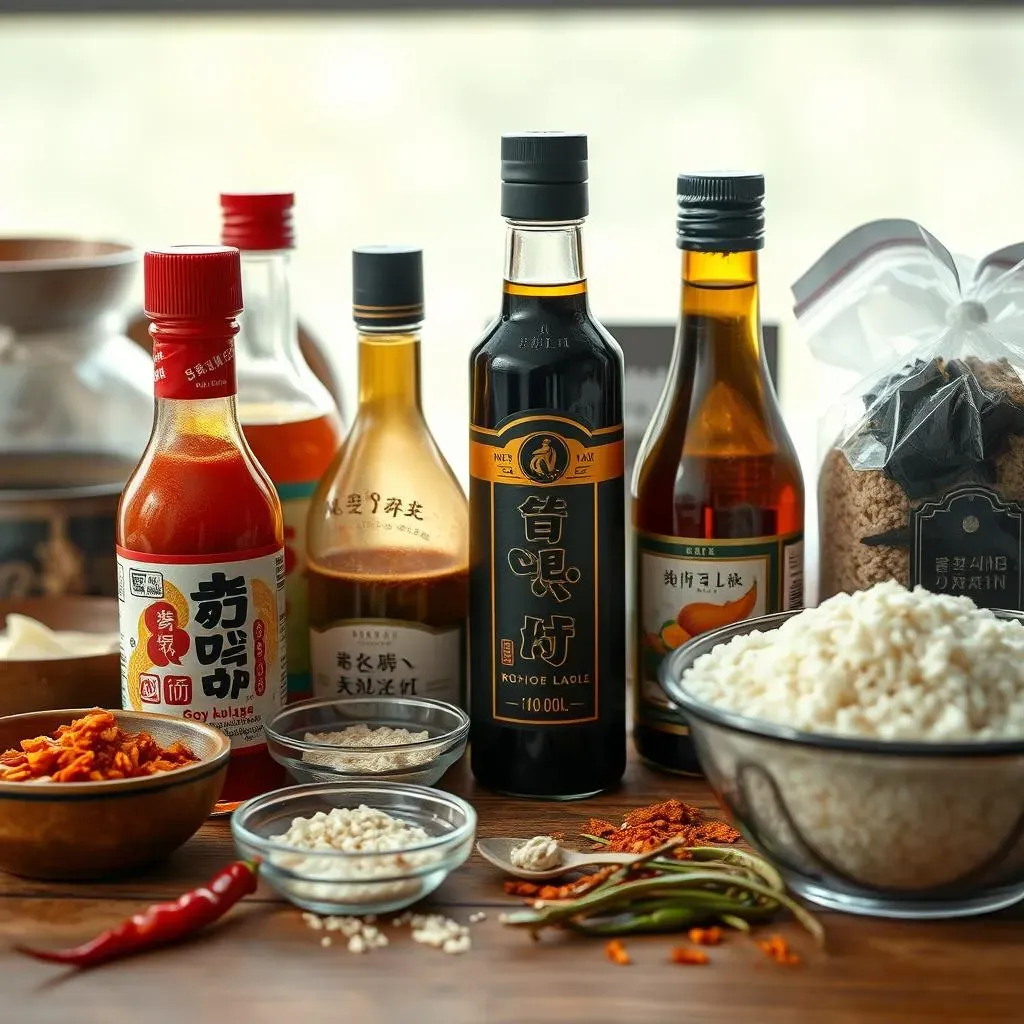Table of Contents
Are you ready to have your taste buds blown away? Forget everything you think you know about Korean food because we're diving headfirst into the vibrant world of vegetarian Korean cuisine. Yes, you heard right. It's not all about BBQ and bulgogi. There’s a whole universe of plant-based deliciousness waiting to be explored. From spicy kimchi that doesn't need fish sauce to hearty bibimbap bowls packed with colorful veggies, this cuisine is a real game-changer for vegetarians and food lovers alike. This article will guide you through the exciting rise of vegetarian korean food restaurant, highlight must-try dishes, give tips on finding the best spots, and even share secrets to making these fantastic flavors in your own kitchen. Think of this as your personal guide to navigating the wonderful world of vegetarian Korean food. So, grab your chopsticks and let’s get started!
The Rise of Vegetarian Korean Food: A Delicious Trend
The Rise of Vegetarian Korean Food: A Delicious Trend
A Shift in the Culinary Landscape
Korean food has been making waves globally, and it’s not just about the barbecue anymore. More people are exploring plant-based diets, and Korean cuisine is stepping up to the plate. Historically, Korean food often revolves around meat and seafood, but that's rapidly changing. The demand for vegetarian and vegan options has pushed chefs to get creative, resulting in an explosion of flavorful, veggie-packed dishes. I've seen it firsthand, from small family-run restaurants to trendy spots in big cities, the vegetarian Korean scene is growing fast, and I am here for it.
It is fascinating to see how traditional dishes are being reimagined. Think of the classic kimchi, usually made with fish sauce. Now, you can find versions using seaweed or mushrooms that are just as delicious. The adaptability of Korean flavors makes it perfect for plant-based cooking. It’s a testament to how a cuisine can evolve and embrace new dietary preferences without losing its essence. This isn't just a trend; it's a delicious transformation that's here to stay.
Traditional Ingredient | Vegetarian/Vegan Substitute |
|---|---|
Fish Sauce | Seaweed, Soy Sauce, Mushroom Broth |
Beef | Tofu, Mushrooms, Jackfruit |
Egg | Tofu, Chickpea Flour |
Why the Surge in Popularity?
Several factors are driving this delicious trend. First, the global move towards healthier eating is a big one. People are more conscious of what they eat, and vegetarian options often align with their health goals. Also, the rise of veganism and vegetarianism as ethical choices is playing a significant role. And let's be honest, Korean food is just incredibly flavorful. It is packed with spices, umami, and textures that are naturally appealing, even without meat. I mean, who can resist a well-seasoned bowl of bibimbap with all the fixings?
Another factor is the growing awareness of Korean culture. From K-dramas to K-pop, there's a global fascination with all things Korean, and that includes the food. As more people explore Korean culture, they're naturally drawn to trying out the cuisine. The vegetarian options offer an accessible way to enjoy the flavors without compromising their dietary choices. It's a perfect storm of health, ethics, and culture that's making vegetarian Korean food a hit worldwide.
MustTry Vegetarian Korean Dishes: Beyond Kimchi
MustTry Vegetarian Korean Dishes: Beyond Kimchi
Bibimbap: A Colorful Bowl of Goodness
Okay, let's talk about Bibimbap. It's like the superstar of Korean vegetarian dishes, and for good reason. Imagine a bowl filled with warm rice, a rainbow of sautéed veggies, a fried egg (or a tofu scramble if you're going full vegan), and a dollop of gochujang, that sweet and spicy red pepper paste. It’s not just a meal; it’s an experience. Every bite is a mix of textures and flavors. The best part? It’s totally customizable. You can add whatever veggies you like, making it a different experience every time. I once had a bibimbap with pickled radish, spinach, mushrooms, and sprouts, it was so good I wanted another one right away.
The key to a great bibimbap is the balance of flavors. The slight bitterness of the greens, the sweetness of the carrots, and the heat from the gochujang all come together perfectly. And don’t even get me started on the crispy rice at the bottom of the bowl. It’s like a little treasure waiting to be discovered. Seriously, if you're new to vegetarian Korean food, bibimbap is the place to start. It’s hearty, healthy, and absolutely delicious. You won’t regret it.
Japchae: Glass Noodles That Dazzle
Next up, let’s talk about Japchae. These are glass noodles made from sweet potato starch, and they're stir-fried with veggies and a savory soy sauce-based dressing. They are slightly sweet, a little salty, and have this amazing chewy texture that’s just addictive. I remember the first time I tried it, I was so intrigued by how the noodles could be so clear and yet so flavorful. It’s a dish that’s both light and satisfying. It's often served at celebrations, but honestly, it’s perfect for any day of the week. I've even made a big batch for a potluck, and it was gone in minutes.
The beauty of Japchae is in its simplicity. The combination of the slippery noodles, the crunchy vegetables, and the savory sauce is just perfect. Common veggies include spinach, carrots, onions, and mushrooms, but you can really use whatever you have on hand. Some variations include tofu or even strips of egg for extra protein. It’s a versatile dish that can be enjoyed hot or cold, making it a great option for lunch or dinner. It's a testament to how simple ingredients, when combined thoughtfully, can create something truly special.
Dish | Key Ingredients | Flavor Profile |
|---|---|---|
Bibimbap | Rice, Veggies, Gochujang, Egg/Tofu | Savory, Spicy, Umami |
Japchae | Glass Noodles, Veggies, Soy Sauce | Sweet, Savory, Chewy |
Tteokbokki: Spicy Rice Cakes That Pack a Punch
Now, for those who like a little heat, we have Tteokbokki. These are chewy rice cakes simmered in a spicy gochujang-based sauce, often with veggies. It’s a classic Korean street food that’s gained huge popularity and for good reason. The sauce is usually a mix of sweet, spicy, and savory, and the chewy texture of the rice cakes is super satisfying. I’ve tried this from street vendors in Seoul, and they’re just as good as the ones I've had in restaurants. It’s the ultimate comfort food with a kick. I remember my first time trying it, my mouth was burning, but I couldn’t stop eating it.
While it’s often made with fish cakes, there are many vegetarian versions that use mushrooms or other veggies to add flavor and texture. The sauce is the star of the show, so make sure it’s well-balanced and packed with flavor. It’s a dish that’s perfect for sharing with friends on a cold day. It’s also a great example of how Korean food can be both exciting and comforting at the same time. If you’re up for something bold and spicy, Tteokbokki is a must-try. It's a flavor adventure that is worth every bite.
Finding the Best Vegetarian Korean Food Restaurant: What to Look For
Finding the Best Vegetarian Korean Food Restaurant: What to Look For
Authenticity and Variety
Alright, so you're on the hunt for the perfect vegetarian Korean food restaurant? First things first, let's talk about authenticity. I'm not saying every place needs to have a grandma in the kitchen, but look for spots that take pride in their traditional flavors. Check out their menus online. Do they offer more than just a token vegetarian dish? A good sign is seeing a variety of options beyond just bibimbap. Look for those less common, but equally delicious dishes, like a flavorful veggie version of Tteokbokki or maybe a hearty bowl of Sundubu Jjigae (soft tofu stew) made with a rich vegetable broth. If they are putting in the effort to offer more than the basics, that is a sign they care about what they're making. I once stumbled upon a tiny hole-in-the-wall place that had a whole vegetarian section on their menu, and it was a flavor explosion.
Also, don’t be afraid to look at the ingredients they use. Do they use fresh, quality produce? Do they make their own kimchi or do they buy it pre-made? Those details can make a huge difference in the overall taste and experience. A restaurant that’s willing to go the extra mile in sourcing ingredients is usually a place that cares about the food they serve. And let's be real, a place that uses fresh, local ingredients usually tastes way better. I always find that when restaurants commit to quality, the food just shines. It's all about finding that balance between tradition and innovation.
Ambiance and Reviews
Okay, so the food is important, but let’s not forget about the vibe. I always say that the ambiance of a restaurant can really make or break the experience. Is it a place where you feel comfortable and relaxed? A good restaurant should have a welcoming atmosphere. It should be clean, well-lit, and have a nice decor that complements the cuisine. I'm not saying you need a fancy place, but a place that feels cared for is usually a good indicator of how they treat their food and customers. Also, don’t forget to check out online reviews. I know, I know, reviews can be all over the place, but they can give you a general sense of what to expect. Look for patterns. Are people consistently raving about certain dishes or mentioning great service? Those are good signs. But also, pay attention to the negative reviews. Are people complaining about the same thing? That could be a red flag. It’s all about gathering information to make an informed decision.
And finally, don't be afraid to ask questions. If you have any dietary restrictions or preferences, call the restaurant ahead of time. A good restaurant should be able to accommodate your needs, or at least let you know if they can't. I find that restaurants that are willing to engage with their customers are usually the ones that are most passionate about their food. So, do your research, trust your gut, and get ready for some amazing vegetarian Korean food. It's all part of the adventure. I once asked a waiter about a specific ingredient, and he brought out the chef, who gave me a whole explanation, it was impressive.
Factor | What to Look For |
|---|---|
Authenticity | Traditional flavors, diverse vegetarian options |
Ingredients | Fresh, quality produce, homemade kimchi |
Ambiance | Welcoming atmosphere, clean and well-lit |
Reviews | Consistent positive feedback, address concerns |
Making Vegetarian Korean Food at Home: Tips and Tricks
Making Vegetarian Korean Food at Home: Tips and Tricks
Stocking Your Pantry: Essential Ingredients
Okay, so you're ready to whip up some vegetarian Korean magic in your kitchen? Awesome! First things first, let's talk about stocking your pantry with the essentials. You don't need a million ingredients, but having a few key items will make your cooking journey so much easier. Think of it like building a flavor foundation. First up, you'll definitely need gochujang, that sweet and spicy fermented red pepper paste that’s the backbone of so many Korean dishes. It adds depth and a wonderful kick. Next, soy sauce is a must, and if you are going full vegetarian, make sure to get a good quality one without fish sauce. Sesame oil is another ingredient that will add a nutty fragrance. And finally, don't forget about rice, short-grain or medium-grain is best for that perfect sticky texture. I always keep these items on hand, and they are the base for most of my Korean meals. I remember when I first started, I was so intimidated by the ingredients, but once you start using them, it’s not so scary.
Beyond the basics, consider adding some dried seaweed for making broths, some dried mushrooms for extra umami, and of course, plenty of fresh veggies. Garlic, ginger, and onions are essential for aromatics. And don't forget about the magic of Korean chili flakes (gochugaru) for adding that signature heat. The key is to have a well-rounded pantry with ingredients that can be mixed and matched in various recipes. And I know it sounds like a lot at first, but you’ll find that once you have these basics, you can create a variety of tasty dishes. It’s all about building your flavor toolbox. Once you've got these down, you’re halfway to becoming a Korean food wizard. Trust me, it's worth the effort.
Essential Ingredient | Why It's Important |
|---|---|
Gochujang | Sweet, spicy, and adds depth |
Soy Sauce (Vegetarian) | Savory base, umami |
Sesame Oil | Nutty fragrance, flavor |
Rice (Short/Medium Grain) | Perfect sticky texture |
Gochugaru (Korean Chili Flakes) | Adds heat and color |
Mastering Basic Techniques: Kimchi and Beyond
Now that you've got your pantry stocked, let’s get into some cooking techniques. One of the most important things to learn is how to make a good kimchi. Yes, it can be a bit intimidating, but it’s totally worth it. Start with a basic recipe, and don’t be afraid to experiment with different veggies. You can use cabbage, radish, cucumber, anything you like. The key to good kimchi is the fermentation process. It’s what gives it that tangy, sour flavor. It's like a science experiment in your kitchen, and the results are so rewarding. I remember the first time I made kimchi, it was a total disaster, but after a few tries, I got the hang of it, and now it's one of my favorite things to make. It is also a fun activity to make with friends.
Beyond kimchi, learn how to make a good gochujang-based sauce. It’s the heart of dishes like Tteokbokki and bibimbap. The balance of sweet, spicy, and savory is crucial. Also, don't be afraid to try stir-frying veggies. The key is to cook them quickly over high heat to retain their crunch and nutrients. And finally, practice your rice cooking skills. The perfect bowl of rice is the base for so many Korean dishes. It should be sticky, but not mushy. It’s a skill that will improve your Korean cooking game significantly. With a little practice and patience, you’ll be whipping up amazing Korean meals in no time. It’s all about taking the first step and being willing to learn along the way. And remember, even the pros started somewhere.
- Start with the basics: Master simple recipes first.
- Don't be afraid to experiment: Try different veggies and spices.
- Practice makes perfect: The more you cook, the better you'll get.
- Enjoy the process: Cooking should be fun and rewarding.
Wrapping Up Our Vegetarian Korean Food Adventure
So, we've journeyed through the exciting landscape of vegetarian Korean cuisine, from its growing popularity to the must-try dishes and how to find the best vegetarian korean food restaurant. We even touched on bringing those fantastic flavors into your own kitchen. It's clear that vegetarian Korean food is not just a trend, but a delicious and vibrant culinary experience that's here to stay. Whether you’re a seasoned vegetarian or just curious about exploring new flavors, this cuisine offers something for everyone. So, go forth, explore, and enjoy every bite of this fantastic food. And who knows? Maybe you'll even inspire a few friends to join you on your next Korean food adventure.